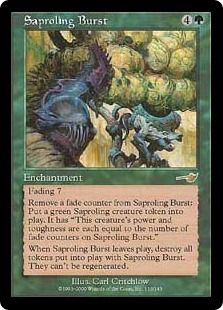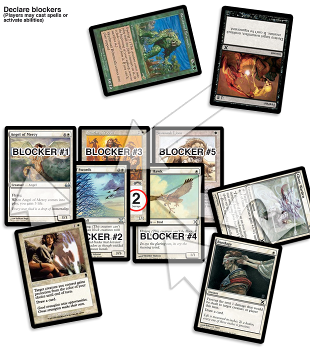
Some close friends on mine run a Magic program at a local library. (I've helped out a bit as well, but certainly can't take credit for the success). Kids learn how to play the game, build decks, trade, and so on, and some even go on to play at FNM and larger events. The library's cardpool is quite a few longboxes large, mostly bulk commons, fueled entirely by donation. There are a few dozen decks built at any one time at a variety of power levels, so no matter how janky of a deck a kid brings in, the library can find something fun to play against it.
As you may know, I love cubes. Furthermore, I think a cube is a valuable way to learn about Magic. It teaches you the same things that doing a real draft does -- the importance of removal, a good mana curve, the right mana base, and two-for-ones -- without costing ten bucks a head. The library didn't have a cube, unsurprisingly, and furthermore offers challenges that I had not faced when designing past cubes.
(I have an uncommons cube that's been well received over the past few years as well as a tribal cube, made in collaboration with 2011 Rookie of the Year Matthias Hunt, in which we address some issues that tend to plague tribal cubes; that is likely to be the topic of a future article.)
Unlike your average cube, library cube needs to be simple. It needs to be accessible to new players so cards need to be easy to evaluate and board complexity is a key concern. Library cube can't be worth anything; I decided to buy all the cards for it rather than go through thousands of bulk commons to see what they already had, and it was ultimately to be given to the library. Despite this, library cube needs to be fun, and make kids interested in drafting.
Perhaps most importantly, the library cube should be in line with the core of Magic. The color wheel is an integral part of Magic and these kids certainly don't know enough about it to understand that sometimes it can be bent.
At this point you may be thinking, "That sounds an awful lot like a core set!" I like your style. Recent sets, M12 prominently among them, have shown us how strong a deck can be just by virtue of having a low curve full of threats. I wanted my cube to stress this as well, rewarding those who were mindful and methodical in their picks rather than allowing greedy, high-variance decks to succeed on bomb power.
Getting Started
The first thing I did was map out the core set commons from M10, M11, and M12. This gave me an idea of the canonical curve each color should have, the number of creatures, flyers, combat tricks, and so on. I did not adhere to this strictly but it was an excellent starting point. I doubled the core set commons run then added some lands, a few artifacts, and a gold section. This brought me to 270 cards, a maximum six-man cube, which seems to be a fine size.
Once I had this template assembled I methodically worked through and filled it in.
The cube is all made of cards with the modern card face. I think consistency is nice here, and it costs us little. This generally limits us to the Modern card pool, though not quite; duel decks and other promotional products have printed non-Modern-legal cards in Modern frames while Timeshifted and Futureshifted cards are Modern legal but do not appear in the modern frame. This was of course annoying given the available search parameters in Gatherer.
Power level is not important, at least not in the way it is for an ordinary cube. I don't need to include the best cards; I do need to make sure that no card is "unplayable" bad compared to the average power level of the cube. For example, I'll play Runeclaw Bear over Darkthicket Wolf even though the wolf is much better. The bear is fine, and complexity is a key concern. I did make sure to include some power variance, as that's what you'll find drafting sealed product, but it's clipped on both ends; the cards range from sometimes playable to strong but I did not include any bombs or chaff. Blaze is present, for example, but there are no Overrun or Mind Control variants because none exist at an appropriate power and complexity level (note that this was built before M13 was released; Switcheroo would probably be a fine Mind Control effect in library cube).
Simplicity is the name of the game in a serious way. As an experienced drafter looking at Ashmouth Hound and Crossway Vampire the key consideration is often the mana cost -- whether you need a two drop or a three drop. Having a lot of text on a card makes that less clear to a new player. I'd rather have them begin by comparing Goblin Piker to Goblin Roughrider, so that's what I included.
I began by mapping out every cost and size that I can get at vanilla on a modern-faced common. In the end vanillas ended up being something like a third of the creatures in this cube. It could have been higher; I left a few out and skipped redundancies like Glory Seeker/Silvercoat Lion.
I also mapped out all of the available French vanillas -- creature with a single evergreen ability. I also included in this category abilities which are basically evergreen, just not keyworded, such as must attack, can't block, repeated pump abilities, new islandhome, high flying, lure, and mana abilities. I also mapped out double French vanillas, such as Nightguard Patrol and Devouring Swarm.
Keeping Things Simple
I did not include regeneration, which is pretty complex, not to mention powerful and annoying. In fact I made sure that not a single card in the cube uses the word regenerate. Perhaps related to this, I did not include any mention of exile. In fact, I ended up leaving out a fair number of things that as an experienced player you may consider a core part of the game.
In the entire cube there are no upkeep or end step triggers. The upkeep and end step are not even mentioned. In fact, I tried to keep the number of repeated triggers as low as possible.
There are no arcane cards or traps, of course. I do include cantrips, however, even though they do not appear in the core set anymore. I believe (and we'll see if I turn out to be right) that they will help new players understand the strength of a two-for-one. The constraints of this cube were such that I really could make very few concessions to flavor so it is a strongly Melvin creation.

Upkeep trigger, counters, tokens, and regeneration. Needless to say, this guy didn't make the cut.
Finally, all multicolored cards in the cube are gold; there is no hybrid mana. You may take this for granted as an experienced player, but drafting with hybrid mana is actually very challenging. You spend a lot of time drafting colored cards without really knowing what colors you're in. That's more sophistication than the target audience of this cube has, so I stuck with plain old gold cards, which are exciting as well as unambiguous.
Finishing Touches
Those who recall my past articles may note that I have an interest in (and some disagreements with) Magic design and may be concerned that I am trying to remake Magic as I think it should be. That's certainly not the case. For example, I included hexproof even though I consider the mechanic to be non-interactive and non-fun -- I wanted to make sure auras were playable -- more on this later. I also left out flash, which I am a strong advocate for, even on core set commons.
My primary concern for this cube was complexity. I want to ease drafters into the Limited format. After filling most of the cube with vanillas and French vanillas, I filled out the last few spots with other simple abilities. These ended up being almost exclusively enters-the-battlefield triggers and death triggers; generally, a creature on the board will do nothing other than attacking and blocking.
My secondary concern is ensuring that games end; this took more work than you may think. There are no bombs in the cube to seal a game. And a cluttered board is daunting to a new player who is wary of losing creatures in combat. The cube started out with only commons, but it quickly became evident that I needed to add a handful of uncommons to each color to help break stalemates. The added beef makes it less likely for a game to stall out. These are typically also French vanillas, just of a larger size than the commons, for example Duskdale Wurm and Thundering Giant.
I also inflated the number of creatures with landwalk to make it easier to push damage through on a cluttered board.
Finally, I put in as many auras as I could find. Especially on an evasive or first striking creature an aura can break a stalemate wide open. In addition, players love to build their own dragons. Of course we all know that auras are bad because they open you up to a two-for-one. I mitigated this somewhat by skewing the removal to more often than not be at sorcery-speed (then, to make sure that removal wasn't nerfed by auras, I chose much of the sorcery speed removal to be effective against creatures that area already enchanted, like Wrack with Madness and Assassinate).
I briefly considered making the entire cube sorcery-speed, like Portal. There are two main problems with this. The first is countermagic: it doesn't work at sorcery speed, and countermagic is a crucial part of the game. There's a bunch of it in the cube, mostly conditional counters, as has become the standard. The second problem is that there just isn't enough selection among modern-faced sorceries to fill this cube with suitably simple spells. In light of these issues I kept instants in.
However, I don't think it's true that a game without instant-speed effects would be boring or trivial. Shuffle up two evenly matched decks with no instant-speed effects and play them against each other. You will find game play to still be challenging and skill-testing, if less exciting.
Parting With My Creation
In fact, you might think a lot of the things I suggest would make this a really boring experience. To you, spoiled by half a dozen new mechanics every year, perhaps it would be. But keep in mind that this is a teaching tool for new players. Drafting is exciting, and in particular the idea of a cube is probably new and interesting to these players. This cube exists to be fun, but also to help them become better drafters. There's plenty of time for variety as they build their repertoires.
I have my original list up here, organized by color and mana cost. However, if you do look at it, I encourage you to take a holistic view. The exact card choices are not that important (for example there are at least a dozen white three-drops that would fit fine; at some point the choices became arbitrary). In fact since I've already given it to the library I can't update it despite the fact that there are several cards in AVR and M13 that would be perfect fits.
The library cube is out of my hands now but I'd be happy to hear what you think about it, about a similar project you may have taken on, or your general opinions about cube drafting with new players.

Comments